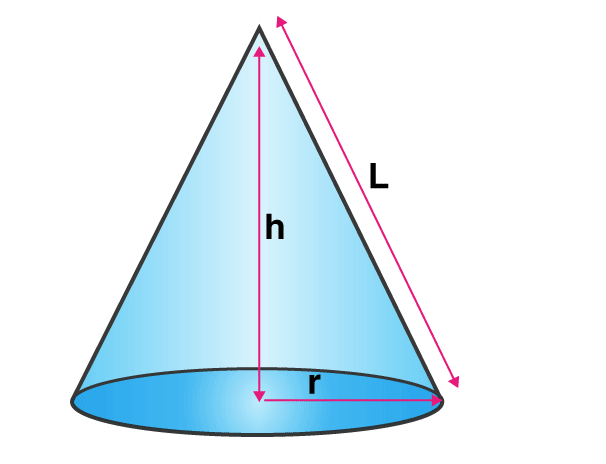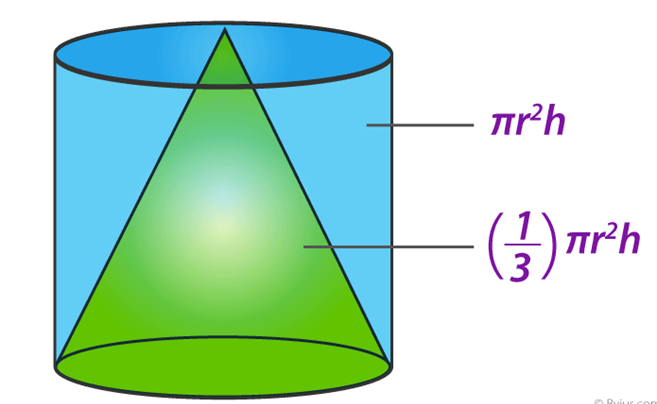- Books Name
- ABCD CLASSES Mathematics Book
- Publication
- ABCD CLASSES
- Course
- CBSE Class 9
- Subject
- Mathmatics
Volume of a Cone
The volume of a cone defines the space or the capacity of the cone. A cone is a three-dimensional geometric shape having a circular base that tapers from a flat base to a point called apex or vertex. A cone is formed by a set of line segments, half-lines or lines connecting a common point, the apex, to all the points on a base that is in a plane that does not contain the apex.
A cone can be seen as a set of non-congruent circular disks that are stacked on one another such that the ratio of the radius of adjacent disks remains constant.
Volume of a Cone Formula
In general, a cone is a pyramid with a circular cross-section. A right cone is a cone with its vertex above the center of the base. It is also called the right circular cone. You can easily find out the volume of a cone if you have the measurements of its height and radius and put it into a formula.

Therefore, the volume of a cone formula is given as
The volume of a cone = (1/3) πr2h cubic units
Where,
‘r’ is the base radius of the cone
‘l’ is the slant height of a cone
‘h’ is the height of the cone
As we can see from the above cone formula, the capacity of a cone is one-third of the capacity of the cylinder. That means if we take 1/3rd of the volume of the cylinder, we get the formula for cone volume.
Note: The formula for the volume of a regular cone or right circular cone and the oblique cone is the same.
Also, read:
Derivation of Cone Volume
You can think of a cone as a triangle that is being rotated about one of its vertices. Now, think of a scenario where we need to calculate the amount of water that can be accommodated in a conical flask. In other words, calculate the capacity of this flask. The capacity of a conical flask is basically equal to the volume of the cone involved. Thus, the volume of a three-dimensional shape is equal to the amount of space occupied by that shape. Let us perform an activity to calculate the volume of a cone.

Take a cylindrical container and a conical flask of the same height and same base radius. Add water to the conical flask such that it is filled to the brim. Start adding this water to the cylindrical container you took. You will notice it doesn’t fill up the container fully. Try repeating this experiment once more, you will still observe some vacant space in the container. Repeat this experiment once again; you will notice this time the cylindrical container is completely filled. Thus, the volume of a cone is equal to one-third of the volume of a cylinder having the same base radius and height.
Now let us derive its formula. Suppose a cone has a circular base with a radius ‘r’ and its height is ‘h’. The volume of this cone will be equal to one-third of the product of the area of the base and its height. Therefore,
V = 1/3 x Area of Circular Base x Height of the Cone
Since, we know by the formula of area of the circle, the base of the cone has an area (say B) equal to;
B = πr2
Hence, substituting this value we get;
V = 1/3 x πr2 x h
Where V is the volume, r is the radius and h is the height.
Solved Examples
Q.1: Calculate the volume if r= 2 cm and h= 5 cm.
Solution:
Given:
r = 2
h= 5
Using the Volume of Cone formula
The volume of a cone = (1/3) πr2h cubic units
V= (1/3) × 3.14 × 22 ×5
V= (1/3) × 3.14 × 4 ×5
V= (1/3) × 3.14 × 20
V = 20.93 cm3
Therefore, the volume of a cone = 20.93 cubic units.
Q.2: If the height of a given cone is 7 cm and the diameter of the circular base is 6 cm. Then find its volume.
Solution: Diameter of the circular base = 6 cm.
So, radius = 6/2 = 3 cm
Height = 7 cm
By the formula of cone volume, we know;
V = 1/3 πr2h
So by putting the values of r and h, we get;
V = 1/3 π 32 7
Since π = 22/7
Therefore,
V = 1/3 x 22/7 x 32 x 7
V = 66 cu.cm.

 Vision classes
Vision classes
